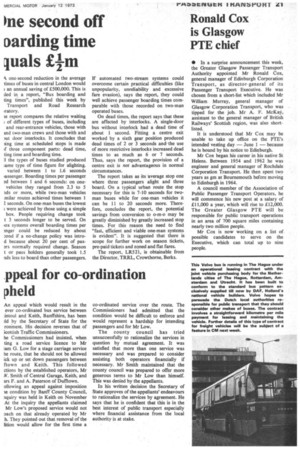Ine second off oarding time
Page 23

If you've noticed an error in this article please click here to report it so we can fix it.
luals Efm
k one-second reduction in the average times of buses in central London would an annual saving of £500,000. This is led in a report, "Bus boarding and ting times", published this week by Transport and Road Research ■ ratory.
le report compares the relative waiting ; of different types of buses, including and rear-entrance vehicles, those with Ind two-man crews and those with and )ut door interlocks. It concludes that ing time at scheduled stops is made
■ fthree component parts: dead time, ting time and boarding time.
[1 the types of buses studied produced ame type of time figure for alighting. varied between 1 to L6 seconds passenger. Boarding times per passenger ad between 1 and 6 seconds; on onevehicles they ranged from 2.3 to 5 ids or more, while two-man vehicles milar routes achieved times between 1 seconds. On one-man buses the lowest ; were achieved by those using a simple box. People requiring change took t 3 seconds longer to be served. On ox systems overall boarding times per !nger could be reduced by about Itond if a no-change policy was introd because about 20 per cent of pas:Ts normally required change. Season t or pass holders generally took 1.5 ads less to board than other passengers. If automated two-stream systems could overcome certain practical difficulties (like unpopularity, unreliability and excessive fare evasion), says the report, they could well achieve passenger boarding times comparable with those recorded on two-man operated buses.
On dead times, the report says that these are affected by interlocks. A single-door bus without interlock had a dead time of about 1 second. Fitting a centre exit worked by a sixth gear position produced dead times of 2 or 3 seconds and-the use of more restrictive interlocks increased dead times to as much as 6 or 7 seconds. Thus, says the report, the provision of a centre exit is not advantageous in normal circumstances.
The report takes as its average stop one where three passengers alight and three board. On a typical urban route the stop necessary for this is 7-10 seconds for twoman buses while for one-man vehicles it can be 11 to 20 seconds more. Therefore, concludes the report, the potential savings from conversion to o-rn-o may be greatly diminished by greatly increased stop times. For this reason the need to find "fast, efficient and viable one-man systems is evident". It is suggested that there is scope for further work on season tickets, pre-paid tickets and zoned and flat fares.
The report, LR52I, is obtainable from the Director, TRRL, Crowthorne, Berks.








































































































